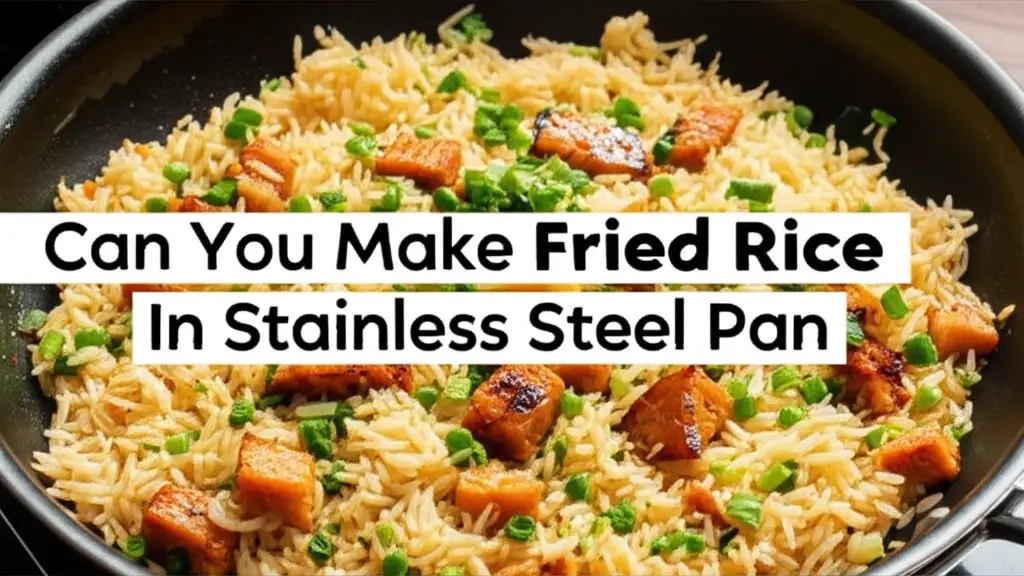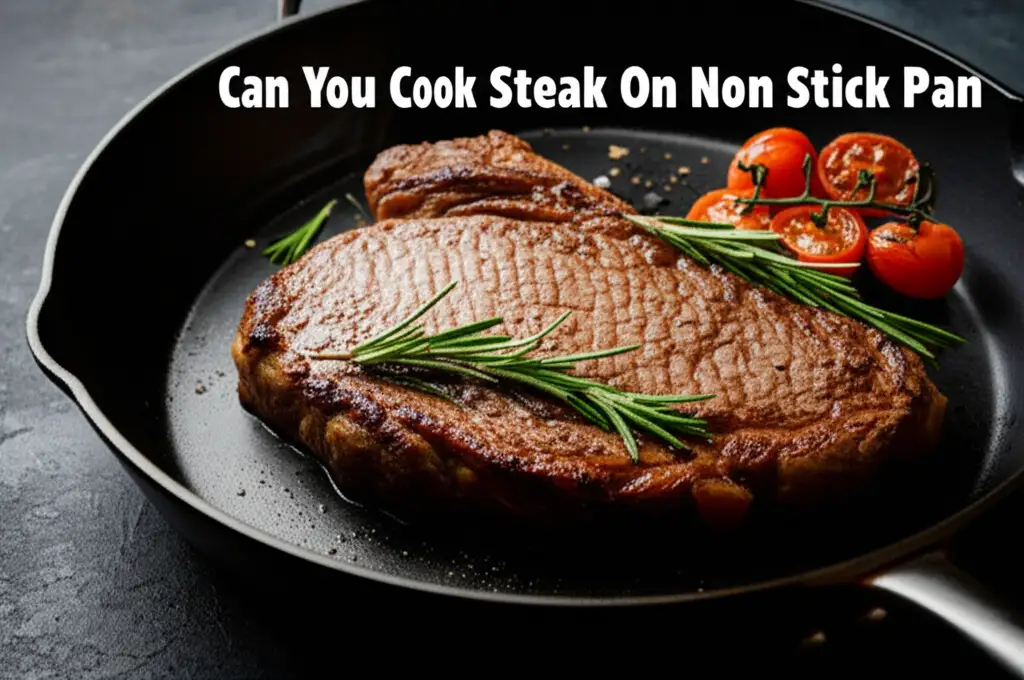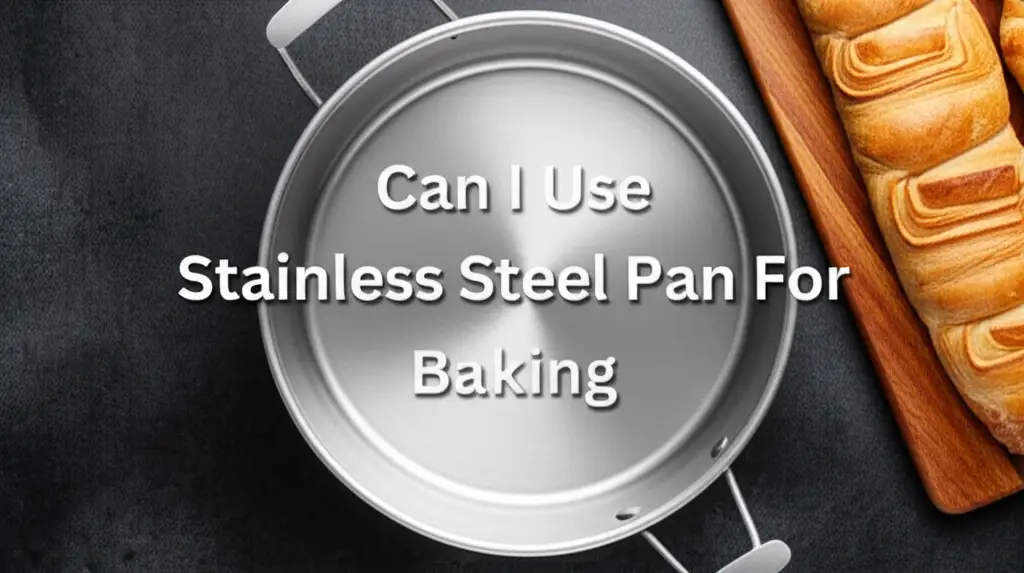· Katria Melrose · Kitchenware Guide · 13 min read
Can You Make Fried Rice In Stainless Steel Pan

Can You Make Delicious Fried Rice In A Stainless Steel Pan?
Imagine golden grains of rice, perfectly separated and coated with savory flavors, dancing in a hot pan. This image often brings to mind a traditional wok, but what if your kitchen only holds a trusty stainless steel pan? Many home cooks wonder, “Can you make fried rice in a stainless steel pan?” The answer is a resounding yes! With the right techniques and a little understanding of your pan, you can achieve restaurant-quality fried rice right in your own kitchen.
This article will guide you through the entire process. We will explore how stainless steel works for stir-frying. You will learn about preparing ingredients correctly. We also cover crucial heat management and practical cooking steps. Finally, we discuss how to troubleshoot common issues and care for your pan. Get ready to elevate your homemade fried rice game.
Takeaway
Achieving excellent fried rice in a stainless steel pan is possible. It requires specific preparation and cooking techniques.
- Use day-old, chilled, dry rice.
- Preheat your pan correctly to prevent sticking.
- Use enough oil with a high smoke point.
- Cook ingredients in batches for proper searing.
- Master heat control for crispy rice and distinct flavors.
- Clean your pan promptly after use for easy maintenance.
Yes, you can absolutely make delicious fried rice in a stainless steel pan. The key lies in proper preparation, precise heat control, and using enough oil. Stainless steel pans offer excellent heat retention and even heating. This makes them suitable for achieving the desired crispy texture in fried rice.
Unlocking Potential: Understanding Stainless Steel for Fried Rice
Stainless steel pans are a staple in many kitchens. They offer durability and excellent heat distribution. Many people think they are only for searing or sautéing. They are great for fried rice, too. The material holds heat well, which is important for stir-frying.
Successful stir-frying demands high, consistent heat. Stainless steel conducts heat effectively. This helps cook food quickly and evenly. It also means you can achieve a good “wok hei” or smoky flavor. This comes from very hot cooking surfaces.
Some people worry about food sticking to stainless steel. This concern is valid if you do not use the pan correctly. However, a properly preheated pan with enough oil creates a non-stick surface. This technique prevents rice and other ingredients from adhering. It helps you get that perfect crispy texture.
Proper initial care makes a difference. When you first get a new stainless steel pan, it helps to clean it well. This removes any manufacturing residues. A simple wash with soap and water works. Then, dry it completely. You can learn more about this first step to ensure your pan is ready for use by reading our guide on how to clean stainless steel pan for the first first time. Preparing your pan correctly sets the stage for a good cooking experience.
Your pan’s thickness also matters. Thicker, heavier stainless steel pans distribute heat more evenly. They maintain a steady temperature better. This helps prevent hot spots that can burn your rice. A good quality pan will make the process easier and more consistent.
Preparing Your Ingredients: The Foundation of Great Fried Rice
Great fried rice starts with great ingredients. The most important ingredient is the rice itself. Do not use freshly cooked rice for fried rice. Fresh rice contains too much moisture. This moisture will make your fried rice mushy.
Always use day-old, chilled rice. Cook the rice the day before you plan to make fried rice. Spread it out on a tray or plate to cool completely. Then, place it in the refrigerator overnight. This process dries out the rice grains. Dry rice separates easily and gets crispy when stir-fried.
Choose the right type of rice. Long-grain varieties work best for fried rice. Basmati or jasmine rice are excellent choices. Their grains stay separate after cooking. Avoid short-grain sticky rice. It clumps together too much. This makes it hard to achieve the desired texture.
Prepare all your other ingredients before you start cooking. This is called “mise en place.” Chop all vegetables. Dice your protein, such as chicken, shrimp, or tofu. Measure out your sauces. Fried rice cooks very quickly. You will not have time to chop or measure during cooking.
Keep your ingredients cold until ready to use. This helps them cook evenly. Separate ingredients into bowls based on cooking time. Proteins usually cook first. Then, hard vegetables like carrots or onions. Softer vegetables like peas or green onions go in last. This organization ensures a smooth cooking process.
Consider adding unique flavors. A small amount of toasted sesame oil adds a nutty aroma. A dash of white pepper provides a subtle kick. Fresh ginger and garlic always enhance the flavor profile. These elements contribute to a truly special dish.
Mastering Heat & Oil: The Stainless Steel Advantage
Heat control is the most critical factor when cooking in stainless steel. It directly impacts whether your food sticks or releases easily. For fried rice, you need high heat. This creates that desirable crispy texture and smoky flavor. Using enough oil is also essential.
First, preheat your stainless steel pan properly. Place the empty pan on medium-high heat. Let it sit for a few minutes. You want the pan to be hot, but not smoking. A common test is the “mercury ball” test. Add a small drop of water to the hot pan. If it sizzles and evaporates quickly, the pan is not hot enough. If it breaks into many small beads and dances around, it is too hot. If it forms one or two large “mercury” beads that glide across the surface, the pan is perfectly heated. Knowing how to tell if stainless steel pan is hot enough prevents sticking.
Once the pan is hot, add your cooking oil. Choose an oil with a high smoke point. Vegetable oil, canola oil, and peanut oil are good options. Use enough oil to coat the bottom of the pan generously. The oil should shimmer but not smoke. The hot oil creates a barrier between the food and the pan surface. This barrier prevents sticking.
The non-stick trick for stainless steel is simple. Heat the pan first, then add oil, then add food. This creates the “Leidenfrost effect” with water, and a smooth layer of oil with food. It is how you get your stainless steel pan to not stick. Do not overcrowd the pan. Cooking in batches ensures consistent high heat. Overcrowding drops the pan temperature. This leads to steaming, not frying. Steamed rice becomes mushy.
Conversely, you must also be careful not to overheat your pan. Too much heat can burn your ingredients quickly. This also makes food stick badly. You will know how to know if stainless steel pan is too hot if the oil immediately smokes or darkens. Reduce the heat if this happens. Adjust heat as you cook. Some ingredients need higher heat, others lower. Constant attention to the pan’s temperature yields the best results.
The Art of Stir-Frying: Step-by-Step Fried Rice Recipe
Making fried rice in a stainless steel pan is an art. It involves quick movements and precise timing. Follow these steps for a delicious meal. Always have your ingredients prepped and ready before you start cooking. This ensures a smooth process.
Start by heating your pan. Follow the “mercury ball” test described earlier. Once hot, add your high smoke point oil. Add enough oil to cover the pan’s bottom. Allow the oil to heat until it shimmers.
Add your proteins first. If using raw meat or shrimp, cook them until just done. Remove them from the pan and set aside. This prevents them from overcooking. If using eggs, scramble them quickly in the hot pan. Push them to the side or remove them.
Next, add your harder vegetables, such as diced carrots or onions. Stir-fry them for a few minutes until they begin to soften. Add aromatics like minced garlic and ginger for the last 30 seconds. Be careful not to burn them. Burnt garlic tastes bitter.
Now, it is time for the rice. Add the day-old, cold rice to the pan. Break up any clumps with your spatula. Spread the rice evenly over the pan surface. Let it sit for a minute or two without stirring. This allows the rice to get crispy on the bottom.
Stir the rice constantly for the next few minutes. Keep it moving to prevent sticking and ensure even cooking. Add your cooked proteins and eggs back into the pan. Mix them well with the rice and vegetables. Add softer vegetables like peas or corn now.
Finally, pour your sauces over the rice. Common sauces include soy sauce, oyster sauce, and a touch of sugar. Mix everything thoroughly. Ensure all ingredients are well coated. Continue stir-frying for another minute or two. The goal is to heat everything through and combine flavors. Serve immediately while hot.
Common Challenges: Solving Fried Rice Setbacks in Stainless Steel
Even experienced cooks face challenges. Making fried rice in stainless steel can present a few common issues. Understanding these problems helps you fix them. Most issues stem from heat, oil, or rice preparation.
One frequent problem is sticking. Your rice or other ingredients cling to the pan surface. This usually happens for two reasons. The pan was not hot enough when you added the oil. Or, you did not use enough oil. Ensure your pan passes the “mercury ball” test before adding oil. Use a generous amount of oil. The oil creates a non-stick layer. If food does stick, do not panic. Often, more oil and gentle scraping can release it. For stubborn spots, you may need to deglaze the pan with a bit of liquid. If you encounter burnt oil residue after cooking, our guide on how to clean burnt oil from stainless steel pan offers effective solutions.
Another issue is mushy fried rice. This indicates too much moisture. The main culprit is fresh rice. Always use day-old, chilled rice. It has less moisture. Spreading the rice thinly in the pan helps moisture evaporate. Do not overcrowd the pan. Cook in smaller batches if necessary. Overcrowding lowers pan temperature and steams food. This leads to mushy results instead of crispy ones.
Bland flavor is another common complaint. This usually means you need more seasoning. Do not rely solely on soy sauce. Consider adding oyster sauce for umami. A pinch of white pepper provides a subtle warmth. Fresh garlic and ginger are crucial flavor builders. Taste your rice as you cook. Adjust seasonings as needed. A small amount of sugar can balance salty flavors.
Uneven cooking can also occur. This is often due to inconsistent heat or not stirring enough. Stainless steel heats evenly, but your stove burner might not. Rotate your pan occasionally to spread heat. Stir the rice frequently but also allow it to sit briefly to crisp. Ensure ingredients are cut to similar sizes. This promotes uniform cooking. Practice helps you get better at judging heat and movement.
Finally, your ingredients might burn quickly. This means your pan is too hot. Reduce the heat slightly. Remember the oil should shimmer, not smoke heavily. A smoking pan means the oil is breaking down. This can impart an unpleasant taste. Adjusting the heat throughout the cooking process is key.
Post-Cook Care: Maintaining Your Stainless Steel Pan
After you enjoy your delicious fried rice, proper pan care is important. Taking care of your stainless steel pan ensures its longevity. It also makes future cooking sessions easier. Cleaning it correctly prevents stains and sticky buildup.
First, let the pan cool down slightly. Do not plunge a very hot pan into cold water. This can cause thermal shock. Thermal shock can warp the pan. A warped pan will not sit flat on your stove. This leads to uneven heating.
Once cooled, fill the pan with hot water and a little dish soap. Let it soak for 10-15 minutes. This helps loosen any stuck-on food bits. For most residue, a sponge or soft brush works well. Scrub the pan thoroughly. Rinse it with clean water.
For stubborn stuck-on food or burnt spots, you can use a few tricks. A paste of baking soda and water can lift tough stains. Apply the paste and let it sit. Then, scrub gently. For tougher situations, boiling water in the pan with a little soap can loosen residue. You can find more comprehensive details on how to clean stainless steel pans in our dedicated guide. This ensures your pan stays spotless.
Always dry your stainless steel pan completely after washing. Water spots can appear if you let it air dry. These are not harmful. They are merely mineral deposits from your water. Use a clean towel to wipe it dry. Proper drying also prevents rust, though stainless steel is highly rust-resistant.
To remove grease from the pan, use hot water and plenty of dish soap. If grease builds up over time, it can become sticky. A good degreasing agent or a stronger dish soap can help. Our article on how to clean grease off stainless steel offers specific techniques. Maintaining a clean cooking surface ensures your pan performs well every time you use it. Store your pan in a dry place. Avoid stacking other cookware directly inside if possible. This prevents scratches on the cooking surface.
FAQ Section
Is stainless steel better than non-stick for fried rice?
Stainless steel offers better heat retention and high-heat searing. This creates crispier fried rice with more flavor. Non-stick pans are easier for beginners, but they do not achieve the same crispy texture. They also have lower heat limits. For truly great fried rice, stainless steel is often preferred by experienced cooks.
Why does my fried rice stick to my stainless steel pan?
Fried rice sticks to a stainless steel pan usually due to insufficient pan preheating or lack of oil. The pan needs to be hot enough to form a non-stick layer when oil is added. Not enough oil also prevents this crucial barrier. Overcrowding the pan can also lower the temperature, leading to sticking.
What oil is best for fried rice in stainless steel?
For fried rice in a stainless steel pan, use oils with a high smoke point. Good options include canola oil, peanut oil, vegetable oil, or grapeseed oil. These oils can withstand the high heat needed for stir-frying without burning. Olive oil has a lower smoke point and is not ideal for this purpose.
Can I use fresh rice for fried rice?
No, it is best not to use fresh rice for fried rice. Freshly cooked rice contains too much moisture. This moisture makes the rice mushy and clumpy when stir-fried. Always use day-old, chilled rice. The chilling process dries out the grains. This allows them to separate and crisp up perfectly.
How do I get a non-stick surface on my stainless steel pan for fried rice?
To create a non-stick surface, heat your empty stainless steel pan on medium-high until it is very hot. A water drop should form a “mercury ball” and glide. Then, add a generous amount of high smoke point oil. Swirl to coat. The hot oil creates a temporary non-stick barrier. This technique prevents food from sticking effectively.
Conclusion
You can indeed make fantastic fried rice in a stainless steel pan. This common kitchen tool can deliver results that rival takeout. You simply need to understand its properties. We have covered the essentials. This includes proper rice preparation, mastering heat control, and the right amount of oil.
Remember to use day-old, chilled rice for that perfect texture. Always preheat your pan thoroughly before adding oil. Do not overcrowd the pan to maintain high heat. Practice these steps. You will soon achieve beautifully separated, flavorful, and crispy fried rice.
Now, it is your turn. Grab your stainless steel pan. Gather your ingredients. Start cooking your best batch of homemade fried rice today. Happy cooking!





